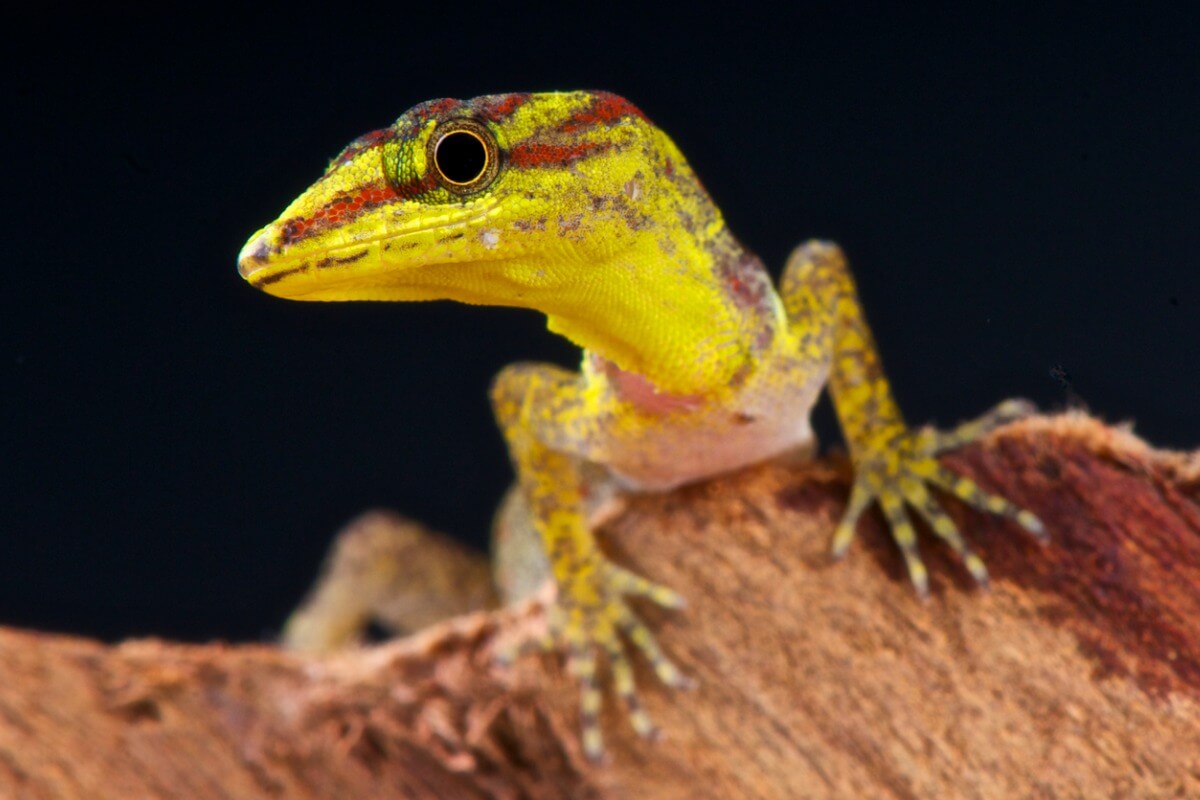Looking After Lizards at Home

It’s common to see lizards sunbathing on rocks when going for a walk in Mediterranean and other sun-baked countries. They’re small, agile, and, above all, beautiful. That’s why we thought it would be a great idea to look at the topic of looking after lizards at home, even if you just need to care for a lizard in distress for a short time.
In this article, you’ll learn all the basics about how to take care of these tiny reptiles; always from the perspective of their rescue, as they aren’t domesticated animals and keeping them in captivity is fraught with difficulties. Let’s make a start!
What is a lizard?

Although this question may seem absurd, the truth is that the word “lizard” encompasses a whole host of small sauropsids that can be observed in natural environments. Unless you know the species that live in your area well, it’s very likely that you would call any reptile you see in the wild a lizard.
For this reason, we’re going to focus on the animal most commonly identified with this word: the Iberian wall lizard (Podarcis hispanicus). This scaly sauropsid belongs to the Lacertidae family and lives, as its name indicates, in the Iberian Peninsula, although it can also be found in North Africa and southeastern France.
They’re small reptiles, reaching barely 6 centimeters (just over 2 inches). Females are smaller, and tend to have two lateral black bands, a more flattened chest and a yellowish belly.
You have probably seen them sunbathing, motionless, on a stone or a wall. This is their natural habitat, as the rocky terrain offers them food, sun, and shelter at the same time. They’re peaceful animals, without strong territorial tendencies.
Is it possible to keep lizards at home?
In Spain, where the Iberian lizard comes from, it isn’t illegal to keep one in captivity, as it isn’t an endangered species. However, this doesn’t mean that it’s ethical to remove them from their natural environment.
As they haven’t gone through a domestication process, the stress of capture and a change of environment will wreak havoc on their health, even causing their death. Therefore, if you insist on keeping one in confined conditions, be sure to adopt it from an exotic animal shelter or buy it from a legal breeder.
Always ask for a certificate that assures that the lizard hasn’t been kidnapped from its environment.
What do I do if I find a lizard in trouble?
Even if you don’t want to keep lizards at home, you could find an injured or sick one. It may not be able to cope on its own and you may have to take it home. In such cases, it’s a good idea to learn about how to look after lizards at home. Let’s take a look at some key points.
Learn about lizard care
Imagine a situation where you have to take a sick lizard into your home, at least until you can bring it to an animal rescue center. In this case, the first thing to do is to visit a veterinarian for them to check its health and make an exhaustive study of the species’ diet, living habits, and environment.
This information will help you to imitate possible the lizard’s habitat in your home as closely as possible. Remember that it’s a wild animal and is specifically adapted to its environment.
Space requirements
As mentioned before, lizards live in rocky environments with abundant sunlight. Therefore, you’ll need a terrarium that’s wider than it is tall and with elements of stone, soil, and some vegetation.
You’ll also need heat sources and a UV lamp. Although it may seem intuitive to place the terrarium in the sun, don’t do it, as the sun through the glass will only cause the lizard to suffer from hyperthermia. The animal must be able to choose between heat and cold to thermoregulate.
Remember to keep the humidity and temperature parameters constant.
Provide a good diet
The Iberian lizard feeds on small insects and arachnids of about 25 millimeters (1 inch) in length. You can give them flies, worms, ants, or spiders. If it’s a rescued animal, then the “food” should be alive, as it must keep its hunting instinct active for when it returns to nature.
In addition, make sure that the lizard always has a bowl with fresh water available. They usually drink a lot of water, both for hydration and to regulate their body temperature.
Caring for lizards isn’t easy

Although you’ve been able to read some basic points about looking after these reptiles, remember that this isn’t an animal for people who don’t have time, space, or resources to look after them. Reptiles are complex animals and don’t always respond to the intuition that we have about the needs of other beings.
So, if you ever find yourself in the situation of having to look after lizards at home, remember to rely on veterinary and wildlife recovery professionals. They’ll help you look after your lizard until it’s healthy enough to be released into the wild.
It’s common to see lizards sunbathing on rocks when going for a walk in Mediterranean and other sun-baked countries. They’re small, agile, and, above all, beautiful. That’s why we thought it would be a great idea to look at the topic of looking after lizards at home, even if you just need to care for a lizard in distress for a short time.
In this article, you’ll learn all the basics about how to take care of these tiny reptiles; always from the perspective of their rescue, as they aren’t domesticated animals and keeping them in captivity is fraught with difficulties. Let’s make a start!
What is a lizard?

Although this question may seem absurd, the truth is that the word “lizard” encompasses a whole host of small sauropsids that can be observed in natural environments. Unless you know the species that live in your area well, it’s very likely that you would call any reptile you see in the wild a lizard.
For this reason, we’re going to focus on the animal most commonly identified with this word: the Iberian wall lizard (Podarcis hispanicus). This scaly sauropsid belongs to the Lacertidae family and lives, as its name indicates, in the Iberian Peninsula, although it can also be found in North Africa and southeastern France.
They’re small reptiles, reaching barely 6 centimeters (just over 2 inches). Females are smaller, and tend to have two lateral black bands, a more flattened chest and a yellowish belly.
You have probably seen them sunbathing, motionless, on a stone or a wall. This is their natural habitat, as the rocky terrain offers them food, sun, and shelter at the same time. They’re peaceful animals, without strong territorial tendencies.
Is it possible to keep lizards at home?
In Spain, where the Iberian lizard comes from, it isn’t illegal to keep one in captivity, as it isn’t an endangered species. However, this doesn’t mean that it’s ethical to remove them from their natural environment.
As they haven’t gone through a domestication process, the stress of capture and a change of environment will wreak havoc on their health, even causing their death. Therefore, if you insist on keeping one in confined conditions, be sure to adopt it from an exotic animal shelter or buy it from a legal breeder.
Always ask for a certificate that assures that the lizard hasn’t been kidnapped from its environment.
What do I do if I find a lizard in trouble?
Even if you don’t want to keep lizards at home, you could find an injured or sick one. It may not be able to cope on its own and you may have to take it home. In such cases, it’s a good idea to learn about how to look after lizards at home. Let’s take a look at some key points.
Learn about lizard care
Imagine a situation where you have to take a sick lizard into your home, at least until you can bring it to an animal rescue center. In this case, the first thing to do is to visit a veterinarian for them to check its health and make an exhaustive study of the species’ diet, living habits, and environment.
This information will help you to imitate possible the lizard’s habitat in your home as closely as possible. Remember that it’s a wild animal and is specifically adapted to its environment.
Space requirements
As mentioned before, lizards live in rocky environments with abundant sunlight. Therefore, you’ll need a terrarium that’s wider than it is tall and with elements of stone, soil, and some vegetation.
You’ll also need heat sources and a UV lamp. Although it may seem intuitive to place the terrarium in the sun, don’t do it, as the sun through the glass will only cause the lizard to suffer from hyperthermia. The animal must be able to choose between heat and cold to thermoregulate.
Remember to keep the humidity and temperature parameters constant.
Provide a good diet
The Iberian lizard feeds on small insects and arachnids of about 25 millimeters (1 inch) in length. You can give them flies, worms, ants, or spiders. If it’s a rescued animal, then the “food” should be alive, as it must keep its hunting instinct active for when it returns to nature.
In addition, make sure that the lizard always has a bowl with fresh water available. They usually drink a lot of water, both for hydration and to regulate their body temperature.
Caring for lizards isn’t easy

Although you’ve been able to read some basic points about looking after these reptiles, remember that this isn’t an animal for people who don’t have time, space, or resources to look after them. Reptiles are complex animals and don’t always respond to the intuition that we have about the needs of other beings.
So, if you ever find yourself in the situation of having to look after lizards at home, remember to rely on veterinary and wildlife recovery professionals. They’ll help you look after your lizard until it’s healthy enough to be released into the wild.
All cited sources were thoroughly reviewed by our team to ensure their quality, reliability, currency, and validity. The bibliography of this article was considered reliable and of academic or scientific accuracy.
- Centro de Recuperación de Animales Silvestres (CRAS). (2022, 22 junio). Comunidad de Madrid. Recuperado 5 de agosto de 2022, de https://www.comunidad.madrid/centros/centro-recuperacion-animales-silvestres-cras
- Ibérica, F. (2011, 27 agosto). Lagartija ibérica (Podarcis hispanica). Fauna Ibérica. Recuperado 5 de agosto de 2022, de https://www.faunaiberica.org/lagartija-iberica
This text is provided for informational purposes only and does not replace consultation with a professional. If in doubt, consult your specialist.








